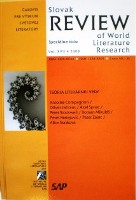Transformácie „poetiky chaosu“ v poľskom, českom a slovenskom kultúrnom kontexte
TRANSFORMATIONS OF THE POETICS OF CHAOS IN POLISH, CZECH AND SLOVAK CULTURAL CONTEXT
Author(s): Pavel MatejovičSubject(s): Literary Texts
Published by: SAV - Slovenská akadémia vied - Ústav svetovej literatúry
Keywords: Chaos; Chance; Structure; Configuration
Summary/Abstract: In the overview study the author outlines “the poetics of chaos”, which is programmatically present in Polish, Czech and Slovak cultural context approximately from the 1960s. He also asks whether this term can be understood as a legitimate and a correct literary-aesthetic category or whether we should rather speak about an estranging metaphor which arches over the problematic of dynamic, non-linear and pulsating structures. Although it is a term describing processes in natural sciences (quantum physics, deterministic chaos and fractal geometry) it is gradually emerging in human sciences (especially in philosophy, aesthetics and literary science). In a short historical sketch, the author of the study follows the beginnings of this poetics in modern art, in the avant-garde, in formalism and in Czech structuralism. He considers Mukařovský’s article Intentionality and Non-Intentionality in Art (Záměrnost a nezáměrnost v umění) to be the key text in which Mukařovský argues that a work of art as a whole is not only a product of an intentional creative process but of many things that transcend intentionality. Mukařovský’s text paves the way to “the poetics of chaos”. By the same token, chaos can be seen as something in the background, as a contrasting and at the same time a complementary element to order (chaos and order are always present). The author directs attention to two studies from the 1960s. The first one is J. Bartoš’ Category of the Accidental in the History of Philosophical Thinking (Kategorie nahodilého v dějinách filosofického myšlení, 1965) which similarly to Kosík’s Dialectics of Concrete (Dialektika konkrétního, 1966) develops the Marxist philosophy, previously tied to the ideological dogmatism of the 1950s. The second study is Stanisław Lem’s Philosophy of Chance (Filozofia przypadku, 1968) whose philosophical impact not only closes up the temporal context but also creates the theoretical point for the present thinking of “the aesthetics of chaos” as well as the deconstruction or post-structuralism. The article further explores the influence of “the poetics of chaos” on theoretical thinking in the 1980s and in the 1990s. In Czech cultural context it is the collection of papers Geometry of the Living (Geometrie živého, 1989), D. Hodová’ s ... at the edge of chaos... (... na okraji chaosu..., 2001), and in Slovakia O. Čepan’s Literary-theoreical Articles (Literárnoteoretické state, 2003) and P. Zajac’ Pulsation of Literature (Pulzovanie literatúry, 1993). The author also notes the present development in Poland where Humanists about Chaos Theory (Humaniści wobec teorii chaosu, 2006) and Rafał Koschany’s monograph Chance (Przypadek, 2006) appeared. From the diachronic point of view the author calls the attention to the oscillatory character of this poetics. There are periods in which the need for a formal and semantic unification stresses the basic creative principle. At other times this formal and semantic
Journal: Slovak Review of World Literature Research
- Issue Year: 2008
- Issue No: 03
- Page Range: 85-98
- Page Count: 13
- Language: Slovak

